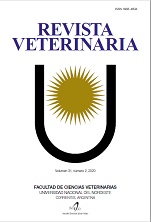Efficacy of timol on the Varroa sp and Nosema sp in beehives used for fecundation in Mexico
DOI:
https://doi.org/10.30972/vet.3124747Keywords:
bees, pathogens, thymol, varricide, nocemicide, prevalenceAbstract
Nowadays, there is a need to identify alternative natural products that do not negatively affect the hive’s productivity and that reduce the presence of various pathogens. Thymol is considered the most natural acaricide against varroasis worldwide, with potential nocemicide effect. Therefore, the objective of this research was to study the impact of thymol on the presence of varroasis and nosemosis on queen mating nucleus hives (Apis mellifera). Sixty five hives were used, in which the level of infestation for Varroa sp, the level of infection for Nosema sp, and the prevalence of both diseases in the population before and after the treatment were determined, based on 4 applications of 20% thymol in icing sugar with a 7-day interval. The prevalence of varroasis and level of Varroa sp infestation decreased after treatment (p<0.05). In contrast, the prevalence of nosemosis (p>0.05) and level of Nosema sp infection were higher after treatment (p<0.05). It can be concluded that, in hives destined for the production of queen mating nucleus, thymol is effective against varroasis but not against nosemosis.Downloads
References
Adamczyk S et al. 2005. Evaluation of residues of essen- tial oil components in honey after different anti-Varroa treatments. JAgric Food Chem 53: 10085-10090.
Alaux C et al. 2010. Interactions between Nosema micro- spores and a neonicotinoid weaken honey bees (Apis mel- lifera). EnvironMicrobiol 12: 774-782.
Amiri E, Strand MK, Rueppell O, Tarpy DR. 2017. Queen quality and the impact of honey bee diseases on queen health: potential for interactions between two major threats to colony health. Insects 8: 48.
Bulacio CN, Basualdo M, Eguaras M. 2010. Actividad varroacida del timol en colonias de Apis mellifera de la Provincia de Santa Fe. In Vet 12: 85-90.
Cantwell GE. 1970. Standard methods for counting Nosema spores. Amer Bee J 110: 222-223.
Conte Y, Ellis M, Ritter W. 2010. Varroa mites and honey bee health: can Varroa explain part of the colony losses? Apidologie 41: 353-363.
Costa C, Lodesani M, Maistrello L. 2010. Effect of thy- mol and resveratrol administered with candy or syrup on the development of Nosema ceranae and on the longevity of honeybees in laboratory conditions. Apidologie 41: 141150.
Dejong D, Dejong P, Goncalves L. 1982. Weight loss and other damage to developing worker honeybees from infes- tation with Varroa jacobsoni. JApicult Res 21: 165-167.
Espinosa LG, Guzmán E. 2007. Effectiveness of two natural miticides, formic acid and thymol, for control of the mite Varroa destructor in honey bees (Apis mellifera) in Villa Guerrero, Mexico. VetMexico 38: 9-19.
Fernández EA, Zavala HJ, Romero CR. 2010. Atlas climático digital de México. Centro de Ciencias de la Atmósfera, UNAM. Available online: http://atlasclimatico. unam. mx/atlas/kml.
Floris I, Satta A, Cabras P, Garau VL, Angioni A. 2004. Comparison between two thymol formulations in the control of Varroa destructor: effectiveness, persistence, and residues. JEconom Entomol 97: 187-191.
Heeve JP et al. 2016. Evaluation of Fumagilin-B and other potential alternative chemotherapies against Nosema cer- anae-infected honeybees (Apis mellifera) in cage trial as- says. Apidologie 47: 617-630.
Higes M et al. 2008. Detection of infective Nosema cera- nae (Microsporidia) spores in corbicular pollen of forager honeybees. J Invertebr Pathol 97: 76-78.
Imdorf A, Bogdanov S, Kilchenmann V. Maquelin C. 1995. Apilife var: a new varroacide with thymol as the main ingredient. Bee World76: 77-83.
Juven B, Kanner J, Schved F, Weisslowicz H. 1994. Fac- tors that interact with the antibacterial action of thyme es- sential oil and its active constituents. JApplMicrobiol 76: 626-631.
Llorente J, Higes M, Suárez M. 1996. Actas del II Congreso de la Sociedad Española de Agricultura Ecológica, Pamplona: orgprints.org/29757/l/actas-pamplona-vd.pdf.
Mahmoud AL. 1999. Inhibition of growth and aflatoxin biosynthesis of Aspergillus flavus by extracts of some egyptian plants. Letters Appl Microbiol 29: 334-336.
Maistrello L et al. 2008. Screening of natural compounds for the control of Nosema disease in honeybees (Apis mel- lifera). Apidologie 39: 436-445.
Montano L, Guzman NE. 2007. Effectiveness of two natural miticides, formia acid and thymol, for control of the mite Varroa destructor in honey bees (Apis mellifera) in Villa Guerrero, Mexico. Vet Mexico 38: 9.
Moreno AA, López MS, Corcho BA. 2000. Principales medidas en epidemiología. SaludPúblMéx 42: 337-348.
Ravoet J et al. 2013. Comprehensive bee pathogen screen- ing in Belgium reveals Crithidia mellificae as a new con- tributory factor to winter mortality. PLoS One 8: e72443.
Reyes FR. 2016. Efectividad de cuatro acaricidas en el control del ácaro (Varroa destructor) en abejas. http://re- positorio.lamolina.edu.pe/handle/UNALM/2755.
Rice RN. 2001. Nosema disease in honeybees. Genetic variation and control (Australian Report). Res & Develop Corp 1: 46.
SPSS Inc. 1999. Statistical package for the social sciences. Chicago, Illinois, USA. https://www.academia.edu.
Unión Europea Diario Oficial. 2007. Regl. Unión Europea N° 834/2007. https://eur-lex.europa.eu/legal-content/ es/TXT/?uri= CELEX:32007R0834.
Viollon C, Chaumont JP. 1994. Antifungal properties of essential oils and their main components upon Cryptococ- cus neoformans. Mycopathologia 128: 151-153.
Williams BA. 2009. Unique physiology of host-parasite interactions in micros- poridia infections. Cellular Microbiol 11: 1551-1560.
Williams GR., Shutler D, Burgher KL, Rogers RE. 2014. Infra-population and community dynamics of the parasites Nosema apis and Nosema ceranae, and conse- quences for honey bee (Apis mellifera) hosts. PLoS One 9: e99465.
Downloads
Published
How to Cite
Issue
Section
License
Revista Veterinaria (Rev. Vet.) maintains a commitment to the policies of Open Access to scientific information, as it considers that both scientific publications as well as research investigations funded by public resources should circulate freely without restrictions. Revista Veterinaria (Rev. Vet.) ratifies the Open Access model in which scientific publications are made freely available at no cost online.











.jpg)
.jpg)



